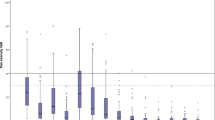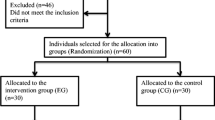Abstract
Background and objective
The aim of this prospective, single-center, controlled clinical trial was to evaluate the effects of menstrual cycle phases on orthodontic pain perception.
Materials and methods
A total of 48 women between 16 and 20 years old with regular menstrual periods who were scheduled to undergo extraction of two upper first premolars for orthodontic treatment were enrolled in this study. Laceback ligatures were used to move canines distally. After activating the laceback ligatures, each patient completed a questionnaire in order to assess pain and quality of life. Pain perception was recorded by patients on a visual analogue scale (VAS) and a verbal rating scale-4 (VRS) immediately after activation (T1) and 24 h after activation (T2). During the appointment, each patient’s menstrual-cycle phase (follicular or luteal) was determined by asking some questions about her cycle. For statistical analysis of data, the Mann–Whitney U, independent t test, and Wilcoxon tests were applied.
Results
Mean orthodontic pain score was 1.96 ± 0.80 and 47.08 ± 21.68 in the follicular phase, 1.92 ± 0.82 and 46.25 ± 18.92 in the luteal phase at T1 using the VRS and VAS, respectively. Orthodontic pain scores were worse in those patients in the luteal phase than those in the follicular phase (p < 0.05) in terms of both VRS (p = 0.025) and VAS (p = 0.046). No significant difference between pain scores at T1 and those at T2 in both luteal and follicular phases (p > 0.05) were observed.
Conclusion
The menstrual phase has an influence on the perception of orthodontic pain which is higher in the luteal phase following the activation of laceback ligatures. In clinical practice, the phases of the menstrual cycle may have a significant role in how women perceive orthodontic pain.
Zusammenfassung
Hintergrund und Zielsetzung
Ziel dieser prospektiven, monozentrischen, kontrollierten klinischen Studie war es, Auswirkungen der Zyklusphase auf die Wahrnehmung von kieferorthopädisch bedingtem Schmerz zu evaluieren.
Material und Methoden
In die Studie aufgenommen wurden insgesamt 48 Frauen im Alter zwischen 16 und 20 Jahren mit regelmäßigem Menstruationszyklus, bei denen im Rahmen einer kieferorthopädischen Behandlung die Extraktion von 2 oberen ersten Prämolaren geplant war. Zur distalen Verschiebung der Eckzähne wurden Laceback-Ligaturen eingesetzt. Nach Aktivierung dieser Ligaturen füllte jede Patientin einen Fragebogen zu Schmerzen und Lebensqualität aus. Die Schmerzwahrnehmung wurde auf einer visuellen Analogskala (VAS) und einer verbalen Skala (“verbal rating scale”, VRS-4) angegeben, sowohl unmittelbar nach der Aktivierung (T1) als auch 24 h danach (T2). Die Zyklusphase (Follikel- bzw. Lutealphase) wurde im Rahmen des Patientinnenkontakts durch Befragen ermittelt. Zur statistischen Analyse wurden der Mann–Whitney-U-Test, der t Test für unabhängige Stichproben und der Wilcoxon-Test verwendet.
Ergebnisse
Zum Zeitpunkt T1 lagen die mittleren Scores bei 1,96 ± 0,80 (VRS) bzw. 47,08 ± 21,68 (VAS) in der Follikelphase und bei 1,92 ± 0,82 bzw. 47,08 ± 21,68 in der Lutealphase. Die Scores der kieferorthopädisch bedingten Schmerzen waren bei den Patientinnen in der Lutealphase höher als bei denen in der Follikelphase (p < 0,05), jeweils mit beiden Tools bestimmt (VRS: p = 0,025; VAS: p = 0,046). Beim Vergleich der Schmerzscores zu den Zeitpunkten T1 und T2 zeigten sich in beiden Zyklusphasen keine statistisch signifikanten Unterschiede (p > 0,05).
Schlussfolgerungen
Im Lauf des Menstruationszyklus verändert sich die Wahrnehmung kieferorthopädisch bedingter Schmerzen, nach Aktivierung von Laceback-Ligaturen ist sie erhöht in der Lutealphase. In der klinischen Praxis kann die Zyklusphase eine wesentliche Rolle dabei spielen, wie kieferorthopädisch bedingte Schmerzen von Patientinnen empfunden werden.


Similar content being viewed by others
References
Banerjee A, Jadhav SL, Bhawalkar JS (2009) Probability, clinical decision making and hypothesis testing. Ind Psychiatry J 18:64–69
Cimino R, Farella M, Michelotti A et al (2000) Does the ovarian cycle influence the pressure-pain threshold of the masticatory muscles in symptom-free women? J Orofac Pain 14:105–111
Collins SL, Moore RA, McQuay HJ (1997) The visual analogue pain intensity scale: what is moderate pain in millimetres? Pain 72:95–97
Cork RC, Isaac I, Elsharydah A et al (2004) A comparison of the Verbal Rating Scale and the Visual Analog Scale for pain assessment. Int J Anesthesiol 8:5p
Diaz A, Laufer MR, Breech LL (2006) Menstruation in girls and adolescents: using the menstrual cycle as a vital sign. Pediatrics 118:2245–2250
Erden V, Yangin Z, Erkalp K et al (2005) Increased progesterone production during the luteal phase of menstruation may decrease anesthetic requirement. Anesth Analg 101:1007–1011
Erdinc AM, Dincer B (2004) Perception of pain during orthodontic treatment with fixed appliances. Eur J Orthod 26:79–85
Goldfien A (1998) The gonadal hormones and inhibitors. In: Katzung BG (ed) Basic and clinical pharmacology. Appleton & Lange, Stamford, pp 653–683
Gosney MB (1985) An investigation into factors which may deter patients from undergoing orthodontic treatment. Br J Orthod 12:133–138
Greenspan JD, Craft RM, LeResche L et al (2007) Studying sex and gender differences in pain and analgesia: a consensus report. Pain 132(Suppl 1):S26–S45
Hanci V, Ayoglu H, Yilmaz M et al (2010) Effect of menstrual cycle on the injection pain due to propofol. Eur J Anaesthesiol 27:425–427
Hanci V, Yurtlu S, Hakimoglu S et al (2010) Brief report: the effects of the menstrual cycle on the hemodynamic response to laryngoscopy and tracheal intubation. Anesth Analg 111:362–365
Hellstrom B, Anderberg UM (2003) Pain perception across the menstrual cycle phases in women with chronic pain. Percept Mot Skills 96:201–211
Jones M, Chan C (1992) The pain and discomfort experienced during orthodontic treatment: a randomized controlled clinical trial of two initial aligning arch wires. Am J Orthod Dentofacial Orthop 102:373–381
Kara I, Ileri Z, Apiliogullari S et al (2011) Recovery after third molar surgery: the effects of phases of the menstrual cycle. Am J Orthod Dentofacial Orthop 140:454 (author reply 454–455)
Kayser V, Berkley KJ, Keita H et al (1996) Estrous and sex variations in vocalization thresholds to hindpaw and tail pressure stimulation in the rat. Brain Res 742:352–354
Koritsanszky N, Madlena M (2011) Pain and discomfort in orthodontic treatments. Literature review. Fogorv Sz 104:117–121
Kuhl H (2002) Influence of the ovarian cycle on the central nervous system. Ther Umsch 59:175–181
Kvam E, Gjerdet NR, Bondevik O (1987) Traumatic ulcers and pain during orthodontic treatment. Community Dent Oral Epidemiol 15:104–107
Ngan P, Wilson S, Shanfeld J et al (1994) The effect of ibuprofen on the level of discomfort in patients undergoing orthodontic treatment. Am J Orthod Dentofacial Orthop 106:88–95
Ohnhaus EE, Adler R (1975) Methodological problems in the measurement of pain: a comparison between the verbal rating scale and the visual analogue scale. Pain 1:379–384
Patel S, McGorray SP, Yezierski R et al (2011) Effects of analgesics on orthodontic pain. Am J Orthod Dentofacial Orthop 139:e53–e58
Riley JL 3rd, Robinson ME, Wise EA et al (1998) Sex differences in the perception of noxious experimental stimuli: a meta-analysis. Pain 74:181–187
Riley JL 3rd, Robinson ME, Wise EA et al (1999) A meta-analytic review of pain perception across the menstrual cycle. Pain 81:225–235
Scott J, Huskisson EC (1979) Accuracy of subjective measurements made with or without previous scores: an important source of error in serial measurement of subjective states. Ann Rheum Dis 38:558–559
Scott P, Sherriff M, Dibiase AT et al (2008) Perception of discomfort during initial orthodontic tooth alignment using a self-ligating or conventional bracket system: a randomized clinical trial. Eur J Orthod 30:227–232
Sherman BM, Korenman SG (1975) Hormonal characteristics of the human menstrual cycle throughout reproductive life. J Clin Invest 55:699–706
Speroff L, Glass RH, Kase NG (1999) Regulation of the menstrual cycle. In: Speroff L, Glass RH, Kase NG (eds) Clinical gynecologic endocrinology and infertility, pp 200–246. Lippincott Williams & Wilkins, Baltimore
Viana Ede S, Bruno SS, Sousa MB (2008) Modulation by progesterone of pain sensitivity to mechanical and ischemic stimuli in young and healthy women. Rev Bras Ginecol Obstet 30:306–311
Viana Ede S, da Silva SB, de Sousa MB (2005) Perception of ischemic and pressing pain in young women during menstrual cycle. Association with humor and cortisol levels. Acta Cir Bras 20(Suppl 1):220–226
Author information
Authors and Affiliations
Corresponding author
Ethics declarations
Conflict of interest
Zehra Ileri, Zeliha Muge Baka, Mehmet Akin, Seza Apiliogullari, and Faruk Ayhan Basciftci state that there are no conflicts of interest.
All studies on humans described in the present manuscript were carried out with the approval of the responsible ethics committee and in accordance with national law and the Helsinki Declaration of 1975 (in its current, revised form). Informed consent was obtained from all patients included in studies.
Additional information
Dr. Zeliha Muge Baka.
Rights and permissions
About this article
Cite this article
Ileri, Z., Baka, Z.M., Akin, M. et al. Effect of menstrual cycle on orthodontic pain perception. J Orofac Orthop 77, 168–175 (2016). https://doi.org/10.1007/s00056-016-0013-9
Received:
Accepted:
Published:
Issue Date:
DOI: https://doi.org/10.1007/s00056-016-0013-9




